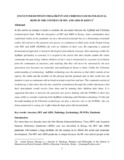ENCOUNTER BETWEEN THEAGĨKŨYŨAND CHRISTIAN ESCHATOLOGICAL HOPE IN THE CONTEXT OF HIV AND AIDS IN KENYA1
Abstract
In this article an attempt is made to examine the encounter between the Agĩkũyũ and Christian
eschatological hope. With the emergence of HIV and AIDS in Kenya, many communities have
confronted reality of the pandemic not as a theoretical principle but as a threatening existential
reality. Of concern to the pastoral care givers, is a situation in which some of the People Living
with HIV and AIDS (PLWHA) die with no children of their own. By employing a pastoral
hermeneutical approach to interpret theological and cultural concepts, their meanings within the
Agĩkũyũ spirituality is assessed. It is argued in the article that their deaths sadden the whole
community because dying without children of one’s own is interpreted as a gesture of exclusion
from the communion of ancestors, and realising that they will never be venerated by the next
generation now becomes an existential and pathological threat to them. Unlike the Christian
understanding of eschatology, Agĩkũyũ eschatology sees the universe as that which consists of two
aspects, the visible and the invisible (or the physical and the spiritual) and, in their world-view, the
duration is seen as continuous with no break in actual events here and now. The community notion of
eschatology is that when they die they would be remembered through the visible inheritance that
their descendants would receive from them and by naming their children after them. It is
suggested that there is need for the pastoral care givers dealing with the PLWHA in their last
stage of life to consider exploring both Agĩkũyũ eschatology and Christian eschatology. To this end,
the understanding of the Christian eschatology can play a decisive role to the PLWHA, who are
dying unmarried or young, for it offers them the hope of new life beyond death.

